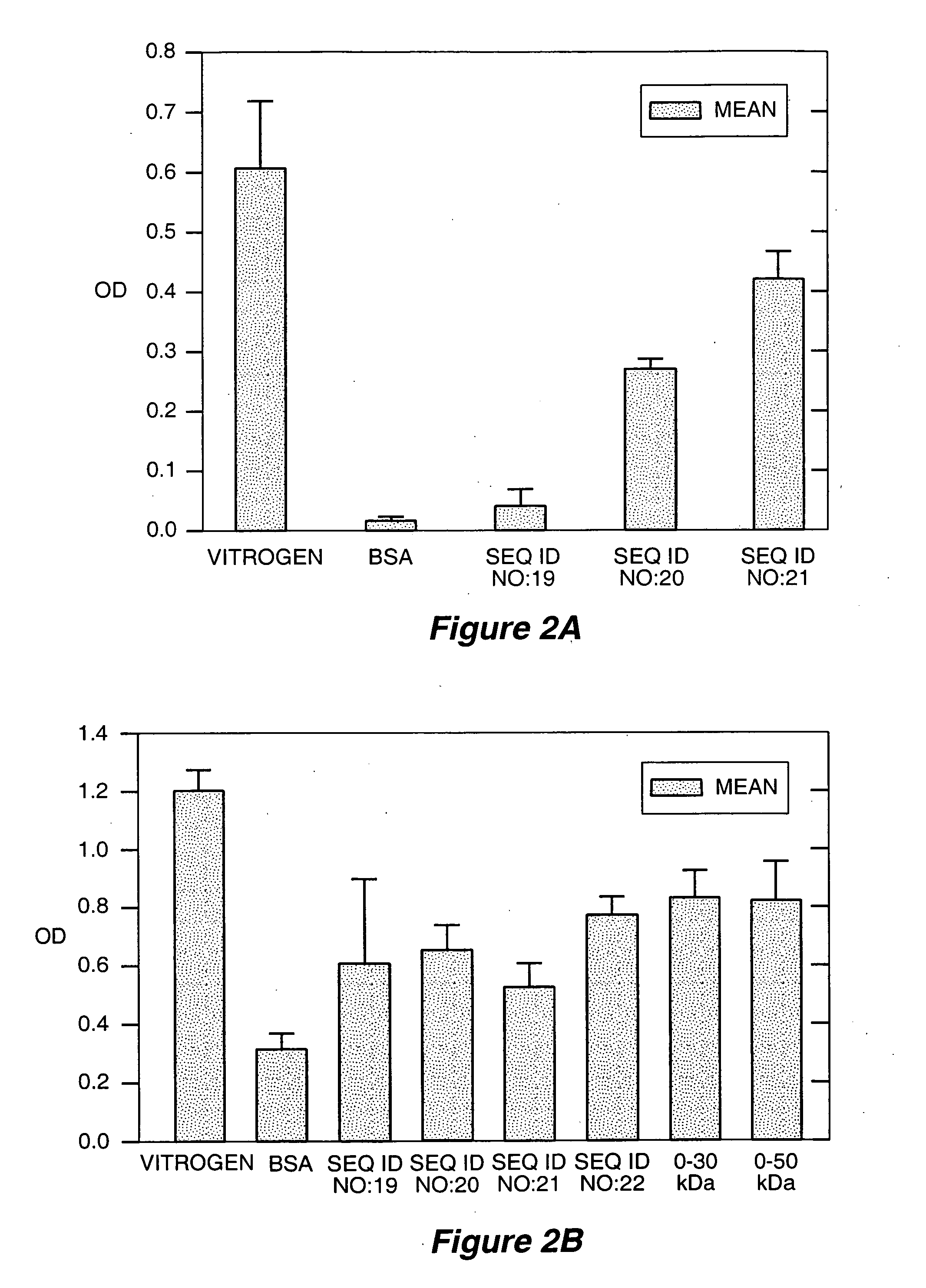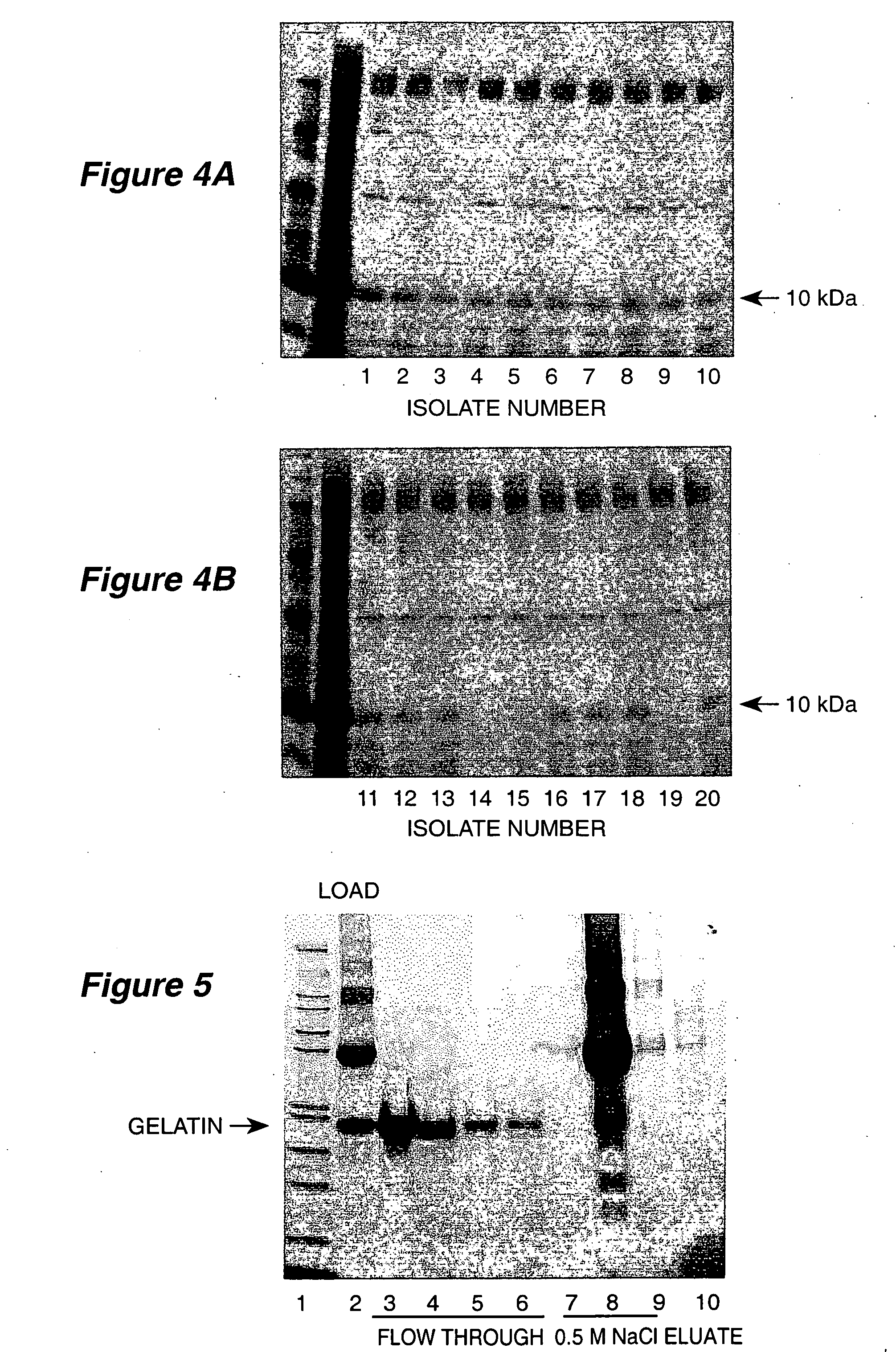Recombinant gelatins
a technology of recombinant gelatin and gelatin powder, which is applied in the field of recombinant gelatin, can solve the problems of insufficient purification steps currently used in the processing of extracting gelatin from animal tissues and bones, inability to remove the likelihood of infectivity due, and requiring harsh and lengthy extraction methods. achieve the effect of uniform product, stably producing significant amounts, and adaptability to different uses
- Summary
- Abstract
- Description
- Claims
- Application Information
AI Technical Summary
Benefits of technology
Problems solved by technology
Method used
Image
Examples
example 1
Direct Expression of Recombinant Gelatins
[0283] Specific fragments of the α1(I) cDNA from human type I collagen were amplified by PCR and cloned into the plasmid pPICZαA or pPIC9K (Invitrogen Corp., Carlsbad, Calif.). The specific PCR primers used in cloning are set forth in Table 1 below. Specific recombinant gelatins are identified in Table 2 as SEQ ID NOs: 15 through 25, and 30, 31, and 33. These recombinant gelatins are additionally identified by reference to human prepro-α1(I) collagen. (Genbank Accession No. CAA98968.) The expression plasmids used contained α1(I) cDNA sequences of different sizes fused to the yeast mating factor alpha prepro secretion sequence. Other signal sequences known in the art can also be used, for example, the yeast invertase (SUC2), the yeast acid phosphatase (PHO) sequences, the native pro-collagen signal sequence, and the signal sequence for human serum albumin. A signal sequence that provides the optimal level of expression for a specific gelatin ...
example 2
Human Recombinant Gelatins Support Cell Attachment Activity
[0290] The recombinant human gelatin fragments of the present invention demonstrated in vitro cell attachment activity. In the following assay, 96-well Maxisorp plates (Nunc) were coated with the following recombinant human gelatin domains from the α1 chain of human type I collagen, as described in Example 1 and listed in Table 2: SEQ ID NO:19, SEQ ID NO:20, SEQ ID NO:21, and SEQ ID NO:22. VITROGEN bovine collagen (Cohesion Technologies; Palo Alto Calif.) and bovine serum albumin served as positive and negative controls, respectively. Each of the proteins was diluted to 0.1 mg / ml in 0.1 M NaHCO3, pH 10.0, and the plates coated overnight at 4° C. Human foreskin fibroblasts (HFF) or human umbilical vein endothelial cells (HUVEC, from Clonetics, passage 5), were seeded onto the coated plates and incubated for 60 minutes at 37° C. Experiments were performed in triplicate.
[0291] The degree of cell attachment was then measured u...
example 3
Identification of a Proteolytically Stable Gelatin Fragment
[0292] Recombinant gelatin fragments were found to be proteolytically modified during their expression and accumulation in the media of recombinant Pichia pastoris cells. Expression of several different portions of the helical domain of the al chain of type I collagen lead to the identification of a recombinant gelatin that had superior stability with respect to proteolysis. Three different gelatin fragments were cloned into plasmid pPICZαA, and their relative stabilities evaluated during recombinant protein expression in Pichia pastoris cells.
[0293] The first strain used is described above in Example 2, corresponding to SEQ ID NO:19. Additional strains were created using plasmids encoding human α1(I) helical domain amino acid residues 179-280 (SEQ ID NO: 15) and 615-715 (SEQ ID NO:23). These recombinant gelatins were constructed as described in Example 1, using primers SEQ ID NO:5 and SEQ ID NO:6, and SEQ ID NO:3 and SEQ ...
PUM
| Property | Measurement | Unit |
|---|---|---|
| molecular weight | aaaaa | aaaaa |
| molecular weight | aaaaa | aaaaa |
| molecular weight | aaaaa | aaaaa |
Abstract
Description
Claims
Application Information
 Login to View More
Login to View More - R&D
- Intellectual Property
- Life Sciences
- Materials
- Tech Scout
- Unparalleled Data Quality
- Higher Quality Content
- 60% Fewer Hallucinations
Browse by: Latest US Patents, China's latest patents, Technical Efficacy Thesaurus, Application Domain, Technology Topic, Popular Technical Reports.
© 2025 PatSnap. All rights reserved.Legal|Privacy policy|Modern Slavery Act Transparency Statement|Sitemap|About US| Contact US: help@patsnap.com



